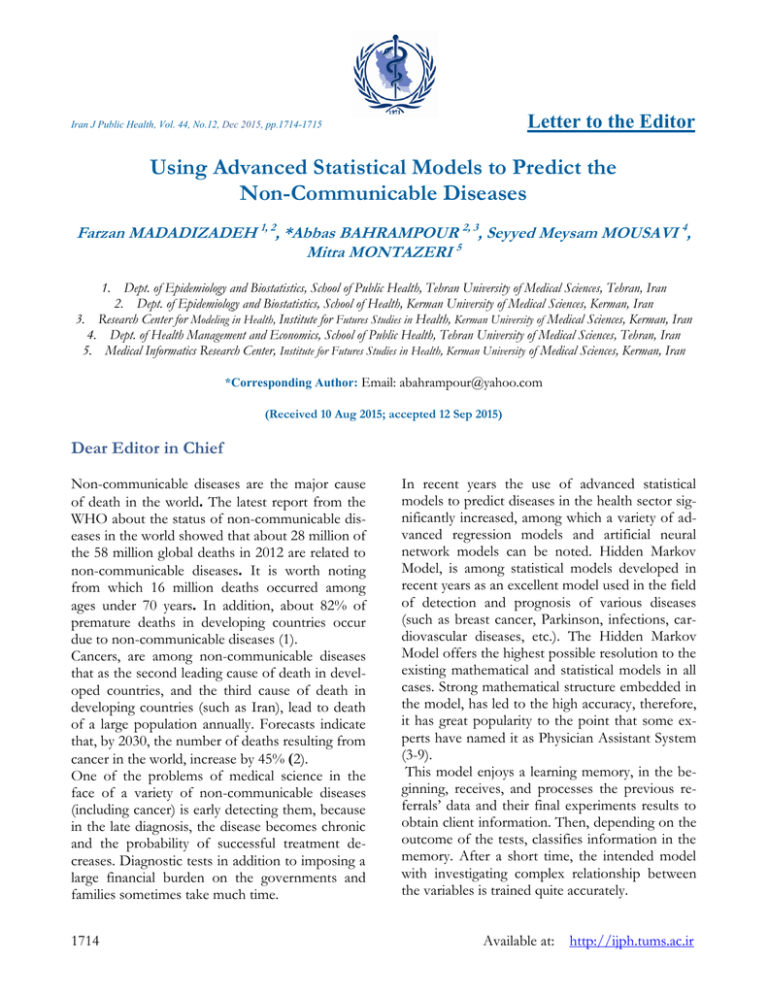Using Advanced Statistical Models to Predict the Non
advertisement

Letter to the Editor Iran J Public Health, Vol. 44, No.12, Dec 2015, pp.1714-1715 Using Advanced Statistical Models to Predict the Non-Communicable Diseases Farzan MADADIZADEH 1, 2, *Abbas BAHRAMPOUR 2, 3, Seyyed Meysam MOUSAVI 4, Mitra MONTAZERI 5 1. Dept. of Epidemiology and Biostatistics, School of Public Health, Tehran University of Medical Sciences, Tehran, Iran 2. Dept. of Epidemiology and Biostatistics, School of Health, Kerman University of Medical Sciences, Kerman, Iran 3. Research Center for Modeling in Health, Institute for Futures Studies in Health, Kerman University of Medical Sciences, Kerman, Iran 4. Dept. of Health Management and Economics, School of Public Health, Tehran University of Medical Sciences, Tehran, Iran 5. Medical Informatics Research Center, Institute for Futures Studies in Health, Kerman University of Medical Sciences, Kerman, Iran *Corresponding Author: Email: abahrampour@yahoo.com (Received 10 Aug 2015; accepted 12 Sep 2015) Dear Editor in Chief Non-communicable diseases are the major cause of death in the world. The latest report from the WHO about the status of non-communicable diseases in the world showed that about 28 million of the 58 million global deaths in 2012 are related to non-communicable diseases. It is worth noting from which 16 million deaths occurred among ages under 70 years. In addition, about 82% of premature deaths in developing countries occur due to non-communicable diseases (1). Cancers, are among non-communicable diseases that as the second leading cause of death in developed countries, and the third cause of death in developing countries (such as Iran), lead to death of a large population annually. Forecasts indicate that, by 2030, the number of deaths resulting from cancer in the world, increase by 45% )2). One of the problems of medical science in the face of a variety of non-communicable diseases (including cancer) is early detecting them, because in the late diagnosis, the disease becomes chronic and the probability of successful treatment decreases. Diagnostic tests in addition to imposing a large financial burden on the governments and families sometimes take much time. 1714 In recent years the use of advanced statistical models to predict diseases in the health sector significantly increased, among which a variety of advanced regression models and artificial neural network models can be noted. Hidden Markov Model, is among statistical models developed in recent years as an excellent model used in the field of detection and prognosis of various diseases (such as breast cancer, Parkinson, infections, cardiovascular diseases, etc.). The Hidden Markov Model offers the highest possible resolution to the existing mathematical and statistical models in all cases. Strong mathematical structure embedded in the model, has led to the high accuracy, therefore, it has great popularity to the point that some experts have named it as Physician Assistant System (3-9). This model enjoys a learning memory, in the beginning, receives, and processes the previous referrals’ data and their final experiments results to obtain client information. Then, depending on the outcome of the tests, classifies information in the memory. After a short time, the intended model with investigating complex relationship between the variables is trained quite accurately. Available at: http://ijph.tums.ac.ir Madadizadeh et al.: Using Advanced Statistical Models to Predict … Then to provide new referrals’ information and experiments to model, by comparing information in the memory, it will predict the best and most accurate way to predict the results of the tests. Since, doing all of the tests for the disease is timeconsuming and costly, the model can predict the ultimate outcome of the tests by accepting the minimum information of people in the shortest possible time. In short, using the mentioned model in order to diagnose a variety of non-communicable diseases can significantly reduce the costs of the health system. Therefore, given that the main concern of the Ministry of Health and policymakers is to reduce costs, increase productivity, and improve the quality of health services, therefore, it is suggested that this model to be more focused with policy makers, and in this way, we can save financial resources and reduce the high costs of the health system. Acknowledgements The authors declare that there is no conflict of interests. 2. 3. 4. 5. 6. 7. 8. References 1. Mendis S, Davis S, Norrving B (2015). Organizational Update The World Health Organization Global Status Report on Noncommunicable Diseases 2014; One More Available at: http://ijph.tums.ac.ir 9. Landmark Step in the Combat Against Stroke and Vascular Disease. Stroke, 46(5):e121-e2. Ferlay J, Soerjomataram I, Dikshit R, Eser S, Mathers C, Rebelo M (2015).Cancer incidence and mortality worldwide: sources, methods and major patterns in GLOBOCAN 2012. Int J Cancer, 136(5):e359-e86. Haffari G, Cai Z, Rahman MS, Nicholson AE (2015). HetFHMM: A novel approach to infer tumor heterogeneity using factorial Hidden Markov model. arXiv preprint arXiv:150300486. Hassan MR, Hossain MM, Begg RK, Ramamohanarao K, Morsi Y(2010). Breastcancer identification using HMM-fuzzy approach. Comput Biol Med, 40(3):240-251. Li H-M, Fang L-Y, Wang P, Yan J-Z (2013). Hidden Markvo Models Based Research on Lung Cancer Progress Modeling. Res J Appl Sci Eng Technol, 6(13): 2470-2473. Vimala K (2014). Stress causing Arrhythmia Detection from ECG Signal using HMM. Stress. IJARCCE, 2(10):6079-6085. Sampathkumar H, Chen X-w, Luo B (2014). Mining adverse drug reactions from online healthcare forums using hidden Markov model. BMC Med Inform Decis Mak,14(1):91. Khorasani A, Daliri MR (2014). HMM for Classification of Parkinson’s Disease Based on the Raw Gait Data. J Med Syst, 38(12):1-6. Rafei A, Pasha E, Orak R (2012). Tuberculosis Surveillance Using a Hidden Markov Model. Iran J Public Health, 41(10):87. 1715


